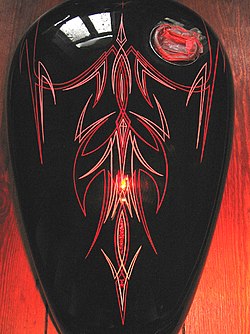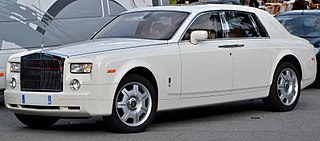
The Rolls-Royce Phantom is a full-sized luxury saloon car made by Rolls-Royce Motor Cars. Launched in 2003, it was the first Rolls-Royce developed and introduced after BMW purchased the right to use the Rolls-Royce name and logo in 1998. It was the seventh Rolls-Royce design to use the Phantom nameplate.
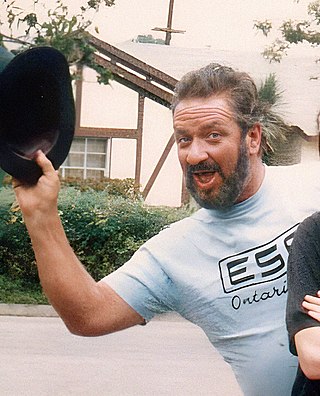
Ed "Big Daddy" Roth was an American artist, cartoonist, illustrator, pinstriper and custom car designer and builder who created the hot rod icon Rat Fink and other characters. Roth was a key figure in Southern California's Kustom Kulture and hot rod movement of the late 1950s and 1960s.

A custom motorcycle is a motorcycle with stylistic and/or structural changes to the 'standard' mass-produced machine offered by major manufacturers. Custom motorcycles might be unique, or built in limited quantities. While individual motorcyclists have altered the appearance of their machines since the first days of motorcycling, the first individualized motorcycles specifically labeled 'Custom' appeared in the late 1950s, around the same time as the term was applied to custom cars.

Kenneth Robert Howard, also known as Dutch, Von Dutch, or J. L. Bachs, was an American motorcycle mechanic, artist, pin striper, metal fabricator, knifemaker and gunsmith.

Von Dutch is an American multinational fashion brand posthumously named after Kenny Howard, a.k.a. "Von Dutch", an American artist and pinstriper of the Kustom Kulture movement. After Howard's death in 1992, his daughters allowed Ed Boswell to produce items using the Von Dutch trademark logo. The trademark rights were sold in 1996 to Mike Cassell who, with Robert Vaughn, used the logo for an apparel line named Von Dutch Originals. French designer Christian Audigier helped popularize the brand in the early 2000s. Von Dutch was repurchased in 2009 by Groupe Royer S.A., through its Luxembourg subsidiary Royer brands International S.a.r.l. In 2024, WSG purchased the global rights from Groupe Royer S.A. and plans to continue to journey of bringing Von Dutch back in a compelling way.

Kustom Kulture is the artworks, vehicles, hairstyles, and fashions of those who have driven and built custom cars and motorcycles in the United States of America from the 1950s through today. It was born out of the hot rod culture of Southern California of the 1960s.

The Landmaster is a unique 12-wheeled amphibious articulated vehicle constructed by Dean Jeffries at Jeffries Automotive in Universal City, California, for the 1977 science fiction film Damnation Alley. Despite the appearance of two Landmasters in the film, only one was built, at a cost of $350,000 in 1976.

A rat rod, as usually known today, is a custom car with a deliberately worn-down, unfinished appearance, typically lacking paint, showing rust, and made from cheap or cast-off parts. These parts can include non-automotive items that have been repurposed, such as a rifle used as a gear shifter, wrenches as door handles, or hand saws as sun visors. Whether or not so appointed, the rat rod uniquely conveys its builder’s imagination.

David Mann was a California graphic artist whose paintings celebrated biker culture, and choppers. Called "the biker world's artist-in-residence," his images are ubiquitous in biker clubhouses and garages, on motorcycle gas tanks, tattoos, and on T-shirts and other memorabilia associated with biker culture. Choppers have been built based on the bikes first imagined in a David Mann painting.
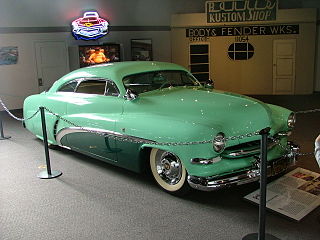
A custom car is a passenger vehicle that has been altered to either improve its performance, change its aesthetics, or a combination of both. Some automotive enthusiasts in the United States want to push "styling and performance a step beyond the showroom floor - to truly craft an automobile of one's own." A custom car in British according to Collins English Dictionary is built to the buyer's own specifications.

A crankpin or crank pin, also known as a rod bearing journal, is a mechanical device in an engine which connects the crankshaft to the connecting rod for each cylinder. It has a cylindrical surface, to allow the crankpin to rotate relative to the "big end" of the connecting rod.

The Orbitron is a custom car built by Ed Roth. It was feared lost until being rediscovered in Mexico in 2007.

A bobber, originally called a bob-job from the 1930s through 1990s, is a style of custom motorcycle. The typical construction includes removing the front fender, shortening the rear fender, which is "bobbed", and stripping excess bodywork as well as all superfluous parts to reduce weight.
A pinstriping brush is the tool of traditional free hand pin stripers use for pin striping. Freehand pin striping is the most difficult method of pin striping and the brush is an important tool for design. Pinstriping brushes have several different designs: Swords, Daggers, and Flats, as well as Double line brushes. The brush consists of a small wood dowel handle, string or brass fixture with adhesive and brush hairs traditionally made from squirrel hair. The small wood dowel is balanced so pin stripers can freely spin the brush between their fingers. The dowel's short length is so the brush does not hit the palm of the hand while the brush is placed in-between the index finger and thumb. The hair of a pinstriping brush is relatively long at approximately 2 inches or more, compared to most artistic brushes of a similar size. This long length is to hold the necessary amount of paint to pull a long line.
Edward Dean Jeffries was an American custom car designer and fabricator, as well as stuntman and stunt coordinator for motion pictures and television programs based in Los Angeles, California.
Mark Whitney Mehran is an American author, business owner, land speed racer, Hot Rod and Chopper builder and Pinstriper. Born and raised in California, Mehran attended Eaglebrook School and Cate School, and graduated from Brown University with an honors degree in English and American Literature.
Dick Dean, born Richard Dean Sawitskas [Sa-WITS-kas], was an American automobile designer and builder of custom cars. Father of Keith Dean.

A camel-hair brush is a type of paintbrush with soft bristles made from natural hairs, usually squirrel. Actual camel hair is not a suitable material, although historically camel was used for ancient Chinese ink brushes. It is a widely used brush in art, but is considered inferior to the more expensive sable and ox-hair brushes. In some niche applications, such as pinstriping, camel hair is an ideal brush. Camel-hair brushes have numerous uses outside of art, particularly dusting where a soft brush is needed for delicate objects or skin.

The car collection of the 29th Sultan of Brunei is the largest private car collection in the world, consisting of approximately 7,000 cars, which have an estimated combined value over US$5 billion. Within his collection of cars, the Sultan's collection of Ferrari F40s, McLaren F1s, and Rolls-Royce vehicles are particularly notable due to the rarity of the vehicles and their value.
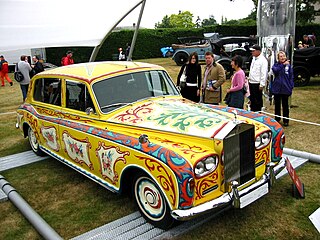
John Lennon's psychedelic Rolls-Royce is an art car created in 1967 and later displayed in many museums.
